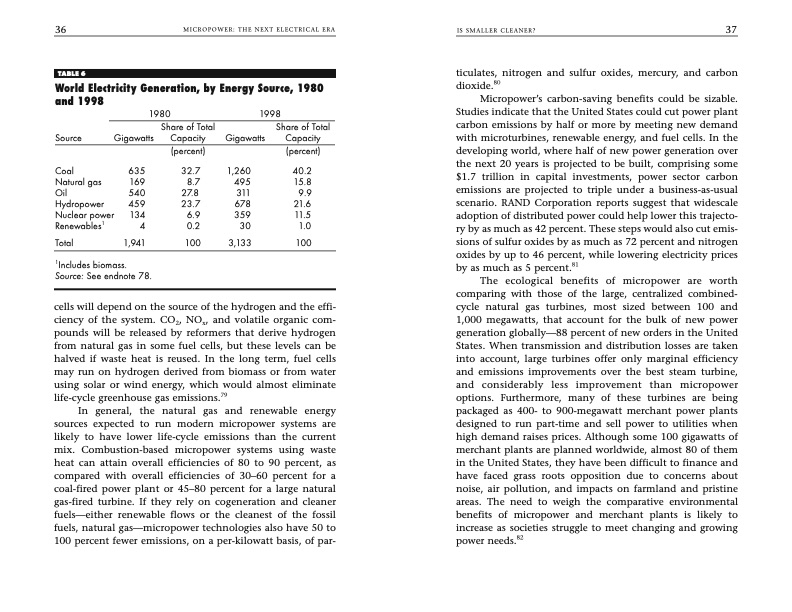
PDF Publication Title:
Text from PDF Page: 019
36 MICROPOWER: THE NEXT ELECTRICAL ERA IS SMALLER CLEANER? 37 TABLE 6 World Electricity Generation, by Energy Source, 1980 and 1998 Share of Total Source Gigawatts Capacity Share of Total Gigawatts Capacity 1980 1998 (percent) (percent) Coal 635 32.7 1,260 40.2 Natural gas 169 8.7 495 15.8 Oil 540 27.8 311 9.9 Hydropower 459 23.7 678 21.6 Nuclear power 134 6.9 359 11.5 Renewables1 4 0.2 30 1.0 Total 1,941 100 3,133 100 1Includes biomass. Source: See endnote 78. cells will depend on the source of the hydrogen and the effi- ciency of the system. CO2, NOx, and volatile organic com- pounds will be released by reformers that derive hydrogen from natural gas in some fuel cells, but these levels can be halved if waste heat is reused. In the long term, fuel cells may run on hydrogen derived from biomass or from water using solar or wind energy, which would almost eliminate life-cycle greenhouse gas emissions.79 In general, the natural gas and renewable energy sources expected to run modern micropower systems are likely to have lower life-cycle emissions than the current mix. Combustion-based micropower systems using waste heat can attain overall efficiencies of 80 to 90 percent, as compared with overall efficiencies of 30–60 percent for a coal-fired power plant or 45–80 percent for a large natural gas-fired turbine. If they rely on cogeneration and cleaner fuels—either renewable flows or the cleanest of the fossil fuels, natural gas—micropower technologies also have 50 to 100 percent fewer emissions, on a per-kilowatt basis, of par- ticulates, nitrogen and sulfur oxides, mercury, and carbon dioxide.80 Micropower’s carbon-saving benefits could be sizable. Studies indicate that the United States could cut power plant carbon emissions by half or more by meeting new demand with microturbines, renewable energy, and fuel cells. In the developing world, where half of new power generation over the next 20 years is projected to be built, comprising some $1.7 trillion in capital investments, power sector carbon emissions are projected to triple under a business-as-usual scenario. RAND Corporation reports suggest that widescale adoption of distributed power could help lower this trajecto- ry by as much as 42 percent. These steps would also cut emis- sions of sulfur oxides by as much as 72 percent and nitrogen oxides by up to 46 percent, while lowering electricity prices by as much as 5 percent.81 The ecological benefits of micropower are worth comparing with those of the large, centralized combined- cycle natural gas turbines, most sized between 100 and 1,000 megawatts, that account for the bulk of new power generation globally—88 percent of new orders in the United States. When transmission and distribution losses are taken into account, large turbines offer only marginal efficiency and emissions improvements over the best steam turbine, and considerably less improvement than micropower options. Furthermore, many of these turbines are being packaged as 400- to 900-megawatt merchant power plants designed to run part-time and sell power to utilities when high demand raises prices. Although some 100 gigawatts of merchant plants are planned worldwide, almost 80 of them in the United States, they have been difficult to finance and have faced grass roots opposition due to concerns about noise, air pollution, and impacts on farmland and pristine areas. The need to weigh the comparative environmental benefits of micropower and merchant plants is likely to increase as societies struggle to meet changing and growing power needs.82PDF Image | Micropower: The Next Electrical Era

PDF Search Title:
Micropower: The Next Electrical EraOriginal File Name Searched:
EWP151.pdfDIY PDF Search: Google It | Yahoo | Bing
Capstone Turbine and Microturbine: Capstone microturbines used and new surplus for sale listing More Info
Consulting and Strategy Services: Need help with Capstone Turbine, sizing systems, applications, or renewable energy strategy, we are here to assist More Info
Container Lumber Dry Kiln: Since 1991 developing and innovating dry kilns using standard shipping containers More Info
Supercritical CO2 Lumber Dry Kiln: Compact fast drying in 3 days or less for small amounts of wood and lumber drying More Info
BitCoin Mining: Bitcoin Mining and Cryptocurrency... More Info
Publications: Capstone Turbine publications for microturbine and distributed energy More Info
FileMaker Software for Renewable Energy Developing database software for the renewable energy industry More Info
CO2 Gas to Liquids On-Demand Production Cart Developing a supercritical CO2 to alcohol on-demand production system (via Nafion reverse fuel cell) More Info
Stranded Gas for low cost power Bitcoin Mining Using stranded gas for generators may provide breakthrough low power costs for cryptocurrency miners. More Info
| CONTACT TEL: 608-238-6001 Email: greg@globalmicroturbine.com | RSS | AMP |